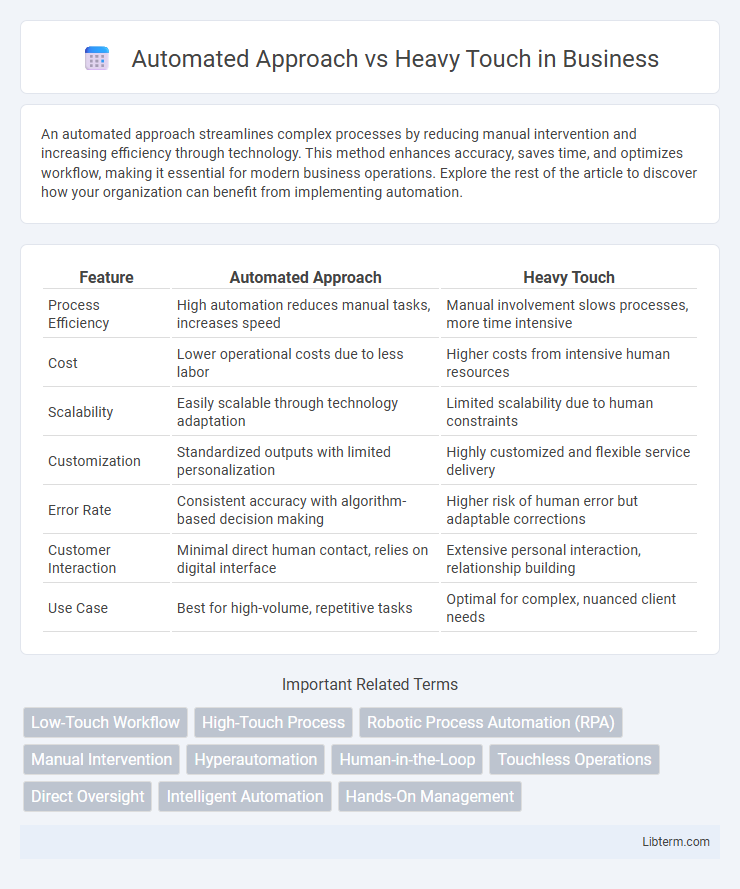An automated approach streamlines complex processes by reducing manual intervention and increasing efficiency through technology. This method enhances accuracy, saves time, and optimizes workflow, making it essential for modern business operations. Explore the rest of the article to discover how your organization can benefit from implementing automation.
Table of Comparison
| Feature | Automated Approach | Heavy Touch |
|---|---|---|
| Process Efficiency | High automation reduces manual tasks, increases speed | Manual involvement slows processes, more time intensive |
| Cost | Lower operational costs due to less labor | Higher costs from intensive human resources |
| Scalability | Easily scalable through technology adaptation | Limited scalability due to human constraints |
| Customization | Standardized outputs with limited personalization | Highly customized and flexible service delivery |
| Error Rate | Consistent accuracy with algorithm-based decision making | Higher risk of human error but adaptable corrections |
| Customer Interaction | Minimal direct human contact, relies on digital interface | Extensive personal interaction, relationship building |
| Use Case | Best for high-volume, repetitive tasks | Optimal for complex, nuanced client needs |
Understanding Automated Approaches
Automated approaches leverage machine learning algorithms and artificial intelligence to streamline repetitive tasks, enabling faster data processing and enhanced scalability. By reducing human intervention, these methods minimize errors and improve consistency, making them ideal for large-scale operations. Understanding key technologies such as robotic process automation (RPA) and natural language processing (NLP) is essential to effectively implement automated solutions and maximize efficiency.
Defining Heavy Touch Methods
Heavy touch methods involve personalized, high-contact interactions such as one-on-one consultations, detailed onboarding sessions, and proactive customer support to ensure deep engagement and tailored experiences. These approaches typically require substantial human resources and time investment to address complex client needs and foster strong relationship building. Heavy touch contrasts with automated approaches by prioritizing human judgment and personalized problem-solving over scalable, algorithm-driven processes.
Key Differences: Automation vs Heavy Intervention
Automation relies on software and algorithms to perform repetitive tasks with minimal human involvement, increasing efficiency and reducing errors. Heavy touch involves intensive manual intervention, requiring skilled professionals to manage complex processes and ensure customization. The key difference lies in scalability, where automation excels in handling large volumes consistently, while heavy touch prioritizes quality and personalization through direct human oversight.
Efficiency and Speed Comparison
Automated approaches significantly enhance efficiency by reducing manual intervention and accelerating task completion, often processing large volumes of data within seconds. Heavy touch methods rely on extensive human input, resulting in slower turnaround times and increased labor costs. Businesses adopting automation experience faster workflows and improved resource allocation compared to traditional, labor-intensive practices.
Cost Implications of Each Approach
Automated approaches drastically reduce labor costs by minimizing human intervention, allowing for scalable and consistent operations with lower variable expenses. Heavy touch methods incur higher costs due to extensive manual involvement, increased training expenditures, and slower processing times that impact overall efficiency. Companies must weigh upfront automation investments against ongoing operational savings to determine the most cost-effective solution for their business model.
Human Error vs Machine Precision
Automated approaches significantly reduce human error by relying on machine precision and consistent algorithmic processes for tasks like data entry, quality control, and decision-making. Heavy touch methods depend on manual human intervention, increasing the risk of mistakes due to fatigue, oversight, or subjective judgment. Machine precision ensures higher accuracy and reliability, enabling scalable operations with fewer errors compared to human-dependent heavy touch workflows.
Scalability and Flexibility
Automated approaches enable scalable and flexible operations by leveraging technology to handle large volumes of tasks with consistent efficiency, reducing manual effort and operational costs. Heavy touch methods rely on intensive human intervention, limiting scalability due to resource constraints and reducing flexibility in adapting quickly to changing demands. Businesses seeking rapid growth and fluid adaptation often prioritize automation to maximize scalability and maintain operational agility.
Industry Applications and Use Cases
Automated approaches streamline processes in industries like manufacturing, logistics, and customer service by utilizing AI and machine learning to enhance efficiency and reduce human error. Heavy touch methods remain essential in sectors such as healthcare and legal services, where personalized expertise and nuanced decision-making are critical for compliance and client trust. Combining automated solutions with heavy touch interventions facilitates optimized workflows in finance and retail, improving both accuracy and customer experience.
Risks and Challenges Involved
Automated approaches reduce human error and increase scalability but face challenges related to system malfunctions, cybersecurity vulnerabilities, and lack of contextual judgment. Heavy touch methods provide thorough oversight and nuanced decision-making but involve higher operational costs, slower processing times, and increased risk of inconsistency due to human fatigue. Balancing automation with human intervention mitigates risks such as data breaches, compliance failures, and process inefficiencies inherent in both models.
Choosing the Right Approach for Your Needs
Selecting the right customer engagement strategy depends on your business goals, target audience, and resource availability. Automated approaches offer scalable solutions with data-driven insights and faster response times, ideal for high-volume interactions. Heavy touch methods emphasize personalized, relationship-driven communication, crucial for complex sales cycles and nurturing long-term client trust.
Automated Approach Infographic

 libterm.com
libterm.com